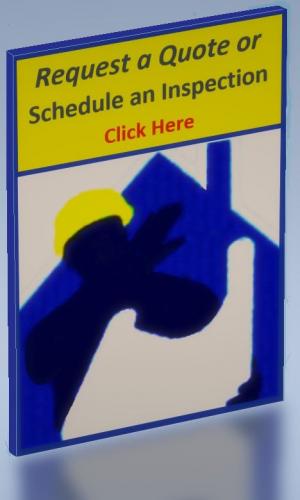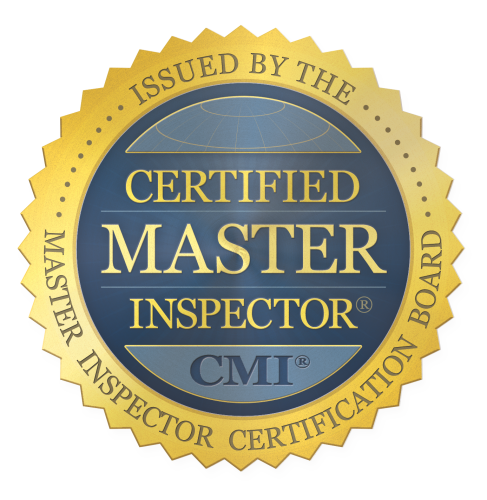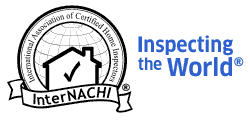Dryer Vent Safety Tips To Keep You Safe
In Your San Antonio Area Home!
.
While doing laundry is likely part of your regular routine, you should always remember the fundamentals of dryer vent safety.
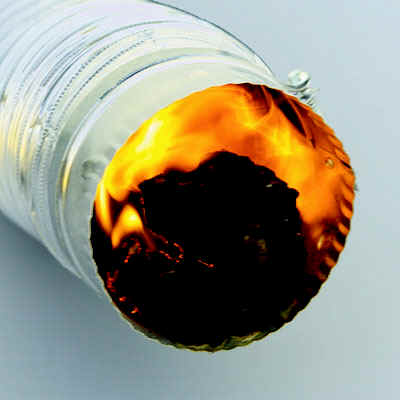 Fires due to dryers make up close to 1000 fires per year. There is an about deaths and around 100 injuries per year in the US due to clothes dryer fires based on current statistics. Clothes dryer fire incidences were higher in the fall and winter months, peaking in the month of January. Most clothes dryer fires occur between the hours of 1 pm and 2 pm. Taking care of your clothes dryer with a few simple safety tips can help secure the safety of your home.
Fires due to dryers make up close to 1000 fires per year. There is an about deaths and around 100 injuries per year in the US due to clothes dryer fires based on current statistics. Clothes dryer fire incidences were higher in the fall and winter months, peaking in the month of January. Most clothes dryer fires occur between the hours of 1 pm and 2 pm. Taking care of your clothes dryer with a few simple safety tips can help secure the safety of your home.
According to the Cushman Insurance group the number one cause of fires in the home is caused by dryers
.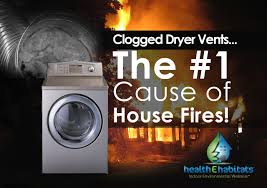
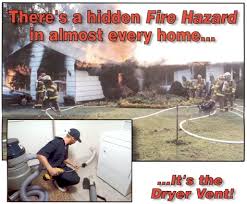
1. Make sure to have your dryer installed and serviced by a professional. Clothes dryers can be found in 81.5 million homes throughout the United States, and there are great risks of damages like overloaded electrical outlets that can result in fires. Gas-powered dryers should also be inspected by a professional occasionally to ensure that the gas line and connection are intact and free of leaks.
2. Clean your clothes dryer. One of the leading causes of home fires is failure to clean your clothes dryer. Excessive lint build up occurs slowly and gradually so that you don't realize it is happening. You think that by cleaning out the lint filter after each use you are doing your job and maintaining the dryer. Not quite! To properly execute the duct cleaning process, you will simply need to brush out your ducts. Perform this cleaning procedure for each section of dryer duct including all the elbows. 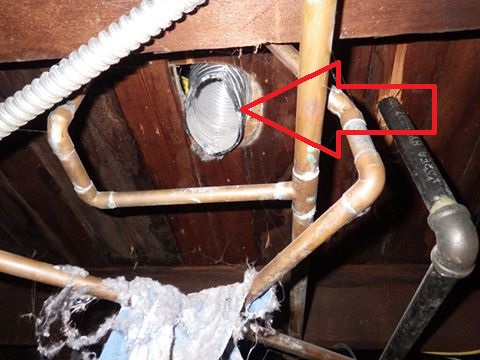 The flex duct type venting shown should not be used inside of walls. Stiff sheet metal ducting is required.
The flex duct type venting shown should not be used inside of walls. Stiff sheet metal ducting is required.
Always clean the lint screen at unit before or after drying each load of clothes. If clothing is still damp at the end of a typical drying cycle or drying requires longer times than normal this may be a sign that the screen or the exhaust duct is blocked. Also make sure the exhaust discharge cap on the outside of the house is cleaned out once a year and has no lint build-up. You are likely to remember cleaning out your vents once a year when you time it according to an annual event like Spring Cleaning. You should also clean behind the dryer, where lint can build up. Have a service professional clean the interior of the dryer chassis periodically to minimize the amount of lint accumulation. Keep the area around the dryer clean and free of clutter. In fact, you can actually use the dryer lint as kindling for your fireplace in a pinch. It is very important to clean the lint trap on your dryer after every use, and to check for lint buildup in your dryer exhaust vent regularly. Check your dryer venting or have someone check it on a regular basis. Just checking the lint filter (lint trap) at unit is not good enough for safety purposes.
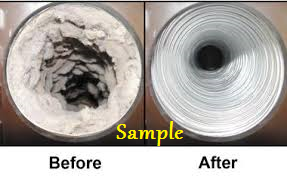 Monitoring and cleaning of dryer ductwork on a regular basis is a must for safety purposes.
Monitoring and cleaning of dryer ductwork on a regular basis is a must for safety purposes.
3. It is NOT OK to vent the dryer directly into the house (or attics- see below) so that the air can be used as either a source of humidity or a source of heat. Clothes dryers evaporate the water from wet clothing by blowing hot air past them while they tumble inside a spinning drum. Some heavy garment loads can contain more than a gallon of water, which, during the drying process, will become airborne water vapor and is supposed to leave the dryer and home through a dryer vent, which is why it is so important that dryers are vented all the way outside of the house. If not, you’ll be pumping a tremendous amount of warm, moist air directly into your home, which is a perfect recipe for creating mold and mildew problems, and you may know the hazards of toxic mold in your house. Air from your dryer vent also carries with it a lot of fine lint particles; not something you want to breath in, but also in high enough concentration, airborne lint is highly flammable. 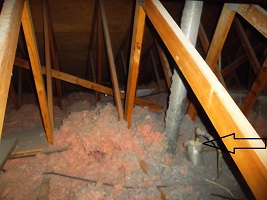 Dryer ducts should not vent into attics either. Picture shows terminated dryer duct in attic (arrow) with lint on side of the other vent pipe next to it and the lint from dryer duct all over insulation (pink insulation in area around dryer vent duct termination is grey from lint covering it).
Dryer ducts should not vent into attics either. Picture shows terminated dryer duct in attic (arrow) with lint on side of the other vent pipe next to it and the lint from dryer duct all over insulation (pink insulation in area around dryer vent duct termination is grey from lint covering it).
According to the International Residential Code (IRC)- Exhaust ducts shall terminate on the outside of the building or shall be in accordance with the dryer manufacturer’s installation instructions. Exhaust ducts shall terminate not less than 3 feet (914 mm) in any direction from openings into buildings. Exhaust duct terminations shall be equipped with a backdraft damper. Screens shall not be installed at the duct termination.
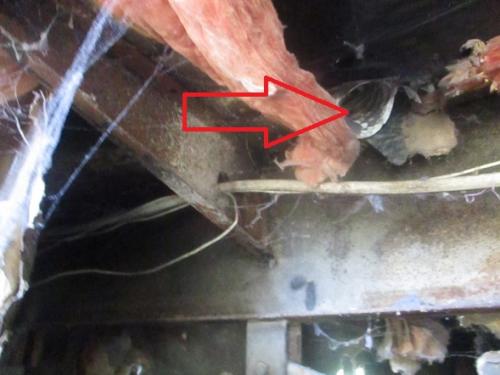 Photo shows improper termination of Dryer Vent below a home in the crawl space.
Photo shows improper termination of Dryer Vent below a home in the crawl space.
4. Take special care when drying clothes that have been soiled with volatile chemicals; such as gasoline, cooking oils, and stains. All volatile chemicals should be removed from clothing before beginning the drying process. Your best choice is to properly dispose of any clothing containing volatile chemicals. If it is safe to wash your garment (check your community’s waste water guidelines) it may be wise to wash the clothing more than once and if you are concerned any oil or chemical is left, preferably hang the clothes to dry. If using a dryer for these clothes, use the lowest heat setting. Ensure you promptly remove the clothing from the dryer at the end of the drying cycle.
5. Keep the dryer vent area clear of flammables. Keep the area around your dryer free from things that might easily catch fire like boxes, cleaning supplies and clothing. Remember that that all dryers should always be properly grounded and its area kept clean.
6. There should not be any type of screen at the dryer vent termination that will trap lint and create a safety hazard. 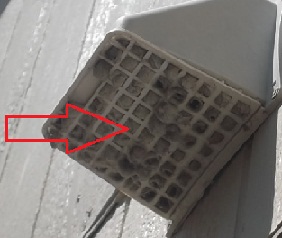 There should be only a backdraft damper or louver flaps at vent termination. Airflow restrictions are a potential fire hazard. Fires may originate within the dryer but spread by escaping through the ventilation duct, incinerating trapped lint, and following its path into the building wall.
There should be only a backdraft damper or louver flaps at vent termination. Airflow restrictions are a potential fire hazard. Fires may originate within the dryer but spread by escaping through the ventilation duct, incinerating trapped lint, and following its path into the building wall.
7. Dryer Vent Duct Restrictions - The maximum length of a clothes dryer exhaust duct shall not exceed 25 feet (7,620 mm) from the dryer location to the wall or roof termination. The maximum length of the duct shall be reduced 2.5 feet (762 mm) for each 45-degree (0.8 rad) bend, and 5 feet (1,524 mm) for each 90-degree (1.6 rad) bend. The maximum length of the exhaust duct does not include the transition duct (from wall to unit).
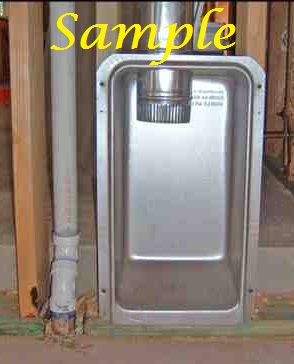 This recessed boxed dryer vent connection type now used in new construction helps prevent behind the dryer, crimps and blockage with the dryer units flex duct connection to the main vent.
This recessed boxed dryer vent connection type now used in new construction helps prevent behind the dryer, crimps and blockage with the dryer units flex duct connection to the main vent.
HOW TO KNOW WHEN THE DRYER VENT NEEDS CLEANING
If your clothes are slow to dry it’s a good bet that your dryer vent is the culprit. Clothes slow to dry? It’s not your dryer – it’s your DRYER VENT that’s causing the problem. Dryers work by blowing heated air through your clothes, which both removes moisture and pulls lint from your clothes. This moisture is normally exhausted to the outdoors through the dryer’s vent. But if the venting duct has become clogged with lint, the moisture cannot be removed properly and 2 or more cycles may be needed to dry your clothes. The electricity used to dry a load of clothes is about $1, so if your dryer suddenly takes double cycles to dry your clothes then the costs multiply quickly.
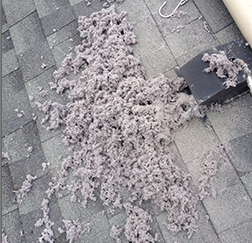 It’s hard to keep track of how clean your ductwork is when it terminates on the roof. Image shows excessive lint out on roof from blockage creating a safety hazard due to blockage.
It’s hard to keep track of how clean your ductwork is when it terminates on the roof. Image shows excessive lint out on roof from blockage creating a safety hazard due to blockage.
Clothes dryers can be found in 80 percent, or 81.5 million homes throughout the United States.
A full load of wet clothes placed in a dryer contains about one half gallon of water. As water is removed, lint is created from the clothes.
Clothes dryers are one of the most expensive appliances in your home to operate. The longer it runs, the more money it costs you.
The U.S. Consumer Product Safety Commission (CPSC) estimates that 15,500 fires associated with clothes dryers occur annually. These fires account for an average of 10 deaths and 310 injuries and more than $100 million in property damage annually. Over 2000 dryer fires in the Ohio area alone.
On a positive note, the number of clothes dryer fires has dropped by 35% from the 24,000 fires that occurred annually, on average, in the late 1970s.
On a final note, turning the dryer off when you leave your home or when you go to bed at night is also a safe practice. Dryer fires cause 35 million dollars in property damage, annually, but the damage is much more contained if someone is available to notice a fire when it is still contained to the dryer or duct work. If you are awake, it is also much less likely you would ever become a fatality statistic due to a dryer fire. So resolve to shut it off on your way out the door or on the way to bed and keep your dryer off when it is not in use. Always remember that LINT IS EXTREMELY FLAMMABLE!
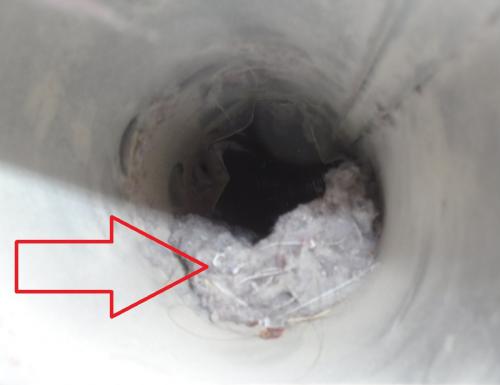
,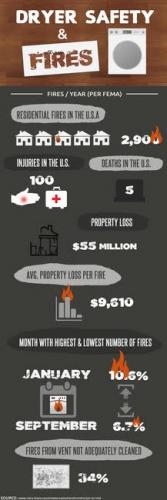
Links to additional Dryer Vent Fire Safety :
By Joseph W. Keresztury- JWK Inspections, San Antonio Home Inspector, Consultant and New Home Construction Specialist.
Additional Info from InterNachi (InterNational Assoc. Of Certified Home Inspectors).
 Fires due to dryers make up close to 1000 fires per year. There is an about deaths and around 100 injuries per year in the US due to clothes dryer fires based on current statistics. Clothes dryer fire incidences were higher in the fall and winter months, peaking in the month of January. Most clothes dryer fires occur between the hours of 1 pm and 2 pm. Taking care of your clothes dryer with a few simple safety tips can help secure the safety of your home.
Fires due to dryers make up close to 1000 fires per year. There is an about deaths and around 100 injuries per year in the US due to clothes dryer fires based on current statistics. Clothes dryer fire incidences were higher in the fall and winter months, peaking in the month of January. Most clothes dryer fires occur between the hours of 1 pm and 2 pm. Taking care of your clothes dryer with a few simple safety tips can help secure the safety of your home. 

 The flex duct type venting shown should not be used inside of walls. Stiff sheet metal ducting is required.
The flex duct type venting shown should not be used inside of walls. Stiff sheet metal ducting is required. Monitoring and cleaning of dryer ductwork on a regular basis is a must for safety purposes.
Monitoring and cleaning of dryer ductwork on a regular basis is a must for safety purposes. Dryer ducts should not vent into attics either. Picture shows terminated dryer duct in attic (arrow) with lint on side of the other vent pipe next to it and the lint from dryer duct all over insulation (pink insulation in area around dryer vent duct termination is grey from lint covering it).
Dryer ducts should not vent into attics either. Picture shows terminated dryer duct in attic (arrow) with lint on side of the other vent pipe next to it and the lint from dryer duct all over insulation (pink insulation in area around dryer vent duct termination is grey from lint covering it). Photo shows improper termination of Dryer Vent below a home in the crawl space.
Photo shows improper termination of Dryer Vent below a home in the crawl space.  There should be only a backdraft damper or louver flaps at vent termination. Airflow restrictions are a potential fire hazard. Fires may originate within the dryer but spread by escaping through the ventilation duct, incinerating trapped lint, and following its path into the building wall.
There should be only a backdraft damper or louver flaps at vent termination. Airflow restrictions are a potential fire hazard. Fires may originate within the dryer but spread by escaping through the ventilation duct, incinerating trapped lint, and following its path into the building wall. This recessed boxed dryer vent connection type now used in new construction helps prevent behind the dryer, crimps and blockage with the dryer units flex duct connection to the main vent.
This recessed boxed dryer vent connection type now used in new construction helps prevent behind the dryer, crimps and blockage with the dryer units flex duct connection to the main vent. It’s hard to keep track of how clean your ductwork is when it terminates on the roof. Image shows excessive lint out on roof from blockage creating a safety hazard due to blockage.
It’s hard to keep track of how clean your ductwork is when it terminates on the roof. Image shows excessive lint out on roof from blockage creating a safety hazard due to blockage.


